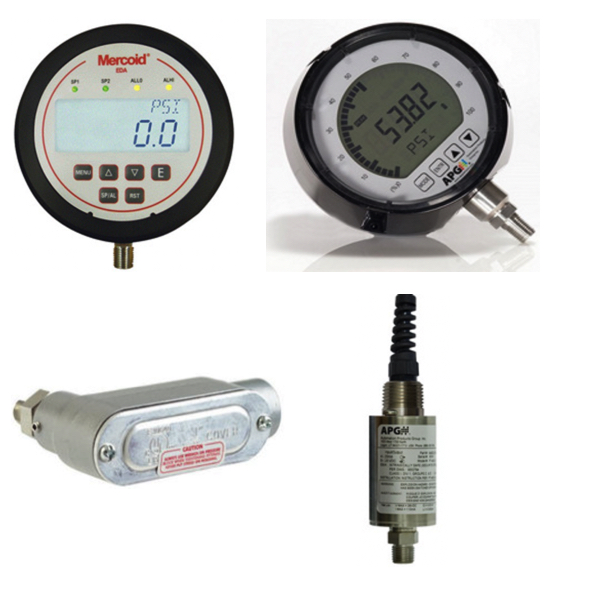Pressure Sensors, Transmitters & Gauges

A gauge pressure sensor is essential for applications like pipelines and storage tanks, where knowing the pressure relative to atmospheric pressure is crucial. But there are many times when we need to monitor pressure in industrial processes with a whole lot more "real-time" technology involved, and that's where pressure transmitters come in. They're not necessarily always used, but they are often found in high-stakes environments because they help ensure safety and because they're just plain efficient as long-term pieces of technology.
Pressure gauges are direct-reading mechanical instruments that indicate pressure in a clear and uncomplicated manner. They are most often employed for simple psi (pounds per square inch) pressure monitoring of hydraulic or pneumatic systems. Although pressure transducers and transmitters can take the place of pressure gauges in some applications, it is really a different kind of animal. You use gauges where you want to see pressure; you use transducers and transmitters where you want to do something with pressure in an automated way.
FAQs
Can a gauge pressure transmitter provide a differential pressure measurement and absolute pressure measurement?
No, gauge pressure transmitters measure pressure relative to atmospheric pressure and cannot provide differential pressure or absolute pressure measurements, which require specialized transmitters designed for those specific tasks.
What are the positive pressure ranges provided by pressure sensors?
Positive pressure ranges provided by pressure sensors typically vary from as low as a few millibars to several thousand psi, depending on the sensor model and application, with industrial sensors commonly covering ranges from 0 to 10,000 psi or higher.
Instrumentation: Elements & Transmitters
2 pieces of hardware used in modern day instrumentation: measuring elements and transmitters.
Measuring Elements
Measuring elements are the part of the device that performs the measurement. For example, the measuring element of a pressure transducer is the part that is actually lowered into a tank that will take a pressure measurement. The measuring element of a flow meter is the part that actually measures the flow and an RTD or thermocouple takes the temperature measurement.
Transmitters
Transmitters collect information from measuring elements and sends the information to where it is needed. The transmitter interfaces with the measuring element and interprets the information. It then sends that information to a PLC, RTU or some other type of control unit. In many cases, the transmitter has the ability to communicate the information via multiple communication protocols. This may be necessary when the measuring element does not send the same type of signal that is needed by the controller. For example, it may be necessary to convert a temperature reading from a thermocouple to a 420 milliamp signal that can be received by a local PLC.

